
|
|
| Red Cloud was born into the Ogallala band. The Ogallala
band was a part of the Sioux nation. Red Cloud was one of the
greatest chiefs of modern times. Red Cloud became not only an
important person for the Ogallala's, he lead the Sioux in a very critical
part in time. He lead them to victory against Colonel William J.
Fetterman for the cause of keeping their land to themselves. Red
Cloud was not about to die softly. He would fight for the justice of
his people and nothing would stop him. But Red Cloud wasn't just a
war leader, he was kind and considerate, too. |
|
|
|
Childhood |
| Red Cloud was born in the 1820's, close to the Platte
River. Many Sioux children grew up in caring environments. Red Cloud
was lucky to have that chance. Red Cloud learned how to be a good
fighter by playing games with other little Sioux boys. Red Cloud had
a gift for telling stories in an enthusiastic way. His ability of
speech was just as important as his fighting capabilities. His talent for speech showed signs of being a good leader. He had nine
siblings, his father was a competent and respected warrior. Red Cloud
is said to have been good with horses and capable of swimming across the
Missouri and Yellowstone rivers. Red Cloud had good self-esteem and
bravery, but he was also polite and kind in everyday situations. He
also had musical and vocal talent. When Red Cloud was about six, his
dad presented him with a colt. His dad told him, "My son, when
you are able to sit quietly upon the back of this colt without saddle or
bridle, I shall be glad, for the boy who can win a wild creature and learn
to use it will as a man be able to win and rule men." Most
young boys would have went to their grandpa for help. However,
little Red Cloud did not. He went directly to practice with his
lariat. Before you knew it, he could lasso the colt. When the
herd of ponies were taken to get a drink, Red Cloud was there to take his
colt for a drink, too. Later on, the pony started getting used to Red
Cloud and allowed himself to be handled. Red Cloud started riding him
bareback. Many times, Red Cloud was bucked from him. He stuck
with it until he no longer needed his lariat. His strategy was to
sit cross-legged and move his body in different ways that guided his
horse. Red Cloud broke all of his horses, and sometimes his
father's. When Red Cloud began attending hunting expeditions,
at nine years of age, he always brought plenty of food home, because of
his greatly trained horses. At twelve, he actually took part in the
hunt. Amazed, he discovered his arrows barely punctured the hide of
the buffalo. With no better idea, he rode his horse up to the buffalo
and tried to push the arrow deep enough into the buffalo to seriously
injure it. The furious buffalo moved his head toward Red Cloud and
knocked him from his horse and the horse form its own feet. Somehow,
Red Cloud was lucky enough to fall on the other side of the horse than the
buffalo. The buffalo charged and the horse took all the force.
The rest of the herd was fleeing, but the very angry buffalo wanted
revenge and wasn't ready to leave. Red Cloud's father had to come
rescue him. Red Cloud learned his lesson about going near any angry
buffalo. |
|
| "Look at me, I was a warrior on
this land where the sun rises, now I come from where the sun sets.
Whose voice was first surrounded on this land- the red people with bows
and arrows. The Great Father says he is good and kind to us. I
can't see
it..."
-Red Cloud |
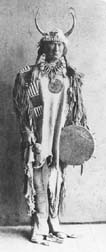
Manikin of Red Cloud |
|
|
Mid-Life; New Experiences |
| When Red Cloud was about sixteen, he was part of a hunting
party in the Big Horn count. This land was somewhat dangerous to
them because their enemies the Crows and Shoshones were near. Red Cloud
was following a buffalo into the Bad Lands, by himself; he brought down his prey, examined his surroundings
(so if something was unusual,
he would know), tied his horse to the buffalo's horn, then began to
skin the buffalo, and cut the meat to pack for camp. All of a
sudden, he heard a war whoop. He looked around and saw that he was
about to be attacked by a huge war group. As a last resort, he tried
to return the war whoop, but only a scream emerged from his lips. His legs gave
out, and he fell to the ground. As serious as this situation sounds,
it has a somewhat funny ending. He stood up to see no warriors, he
imagined this whole ordeal. The war whoop was actually a whinny from
his horse, and the charging army was a herd of elk. |
|
| Red Cloud was twenty-eight when General Harney constructed
the first council at Fort Laramie. The Ogallala's weren't for
signing any treaties. Bear Bull, the Ogallala chief, was under the
influence of whiskey and wanted his people to do what he wanted, he didn't
care what they wanted. Since no one was happy with him, he was
outraged and shot into a group of his own people. Red Cloud's father
and brother were part of that group. It was Red Cloud's
responsibility to pay Bear Bull back for the wrongs he committed,
according to Indian custom. Silently, Red Cloud walked up to Bear
Bull and his son and shot them. This proved that Red Cloud could and
would protect his people from not only enemies, but untrustworthy people
of their own group, too. From then on, Red Cloud was considered a
leader. |
|
| When Red Cloud was thirty-five, the different bands of
Indians were camped near Fort Laramie. Red Cloud told his people
this, in despise of the white men: "Friends, it has been our
misfortune to welcome the white man. We have been deceived. He
brought with him some shining things that pleased our eyes; he brought
weapons more effective than our own: above all, he brought the spirit
water that makes one forget for a time old age, weakness, and
sorrow. But I wish to say to you that if you would possess these
things for yourselves, you must begin anew and out away the wisdom of your
father. You must lay up food, and forget the hungry. When your
house is built, your storeroom filled, then look around for a neighbor
whom you can take at a disadvantage, and seize all that he has! Give
away only what you do not want; or rather, do not part with any of your
possessions unless in exchange for another." |
|
|
Fetterman Massacre |
| in 1862, a trailblazer names John Bozeman was constructing
a trail through the Northern Plains and the Rocky Mountain
foothills. This trail was called the Powder River Trail, but better
known as the Bozeman Trail. This trail wasn't good for the Indians
though. It went through hunting grounds. This very much
disturbed the buffalo. In effect, the Indians were disturbed.
The Indians then raided travelers of the trail. In 1866, a council
at Fort Laramie was called to resolve this issue. |
|
|
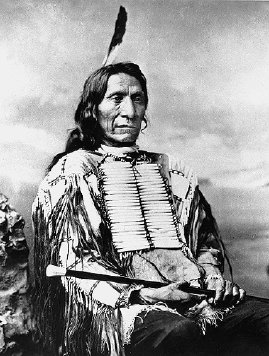
Red Cloud |
"We Indians saw
it as a beautiful place where we can go and pray and to receive something,
perhaps, that is better than the gold that is in there. A lot of our
creation stories and a lot of our Indian medicine came from the Black
Hills."
-Red Cloud |
|
| The Indians called to attend the
council consisted of Red Cloud, Red Leaf, Old Man Afraid of His Horse,
Spotted Tail, and some dedicated followers. As the discussion went
on, it appeared that the Bozeman Trail would still be used, as long as the
travelers left the game alone. Unexpectedly, Colonel Henry
Carrington rode into Fort Laramie (he was on his way to construct forts
along the Bozeman Trial). Carrington announced his troops would
construct forts along the the trail and guard it. Red Cloud was
outraged. He stated, "The Great Father sends us presents and
wants us to sell him the road, but before the Indians say yes or no White
Chief goes with soldiers to steal the road." Then he stormed
out with his followers behind him. Spotted Tail and a few
other chiefs stayed to discuss the treaty, it was made and signed.
Carrington went on his way to construct Fort Reno, Fort Phil Kearney, and
Fort C. F. Smith. Soon, the Sioux warriors were there to attack the
post and let some horses go. Before 1866 was over, the Sioux killed
around 150 men along the trail. Because of those deaths, the trail
got the nickname "Bloody Bozeman". |
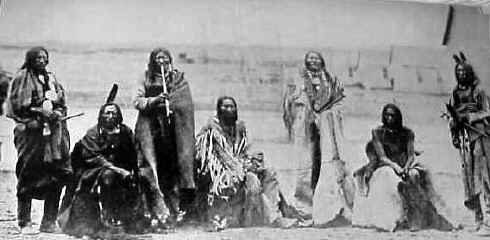
Indians
that were called to attend the council at Fort Laramie
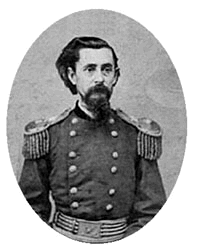
Colonel Henry
Carrington |
|
| The war consisted of a good deal of
harassments. The Sioux interrupted mail routes, destroyed wagon
trains, or forced them back. If you were a soldier looking for
firewood, you were out of luck, they would attack you, also. There was a
group of Sioux camped along the Tongue River. Constantly, the
Indians attacked the White men. |
|
|
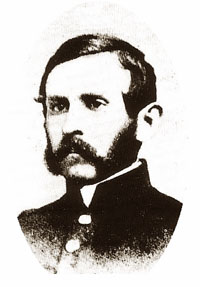
William J.
Fetterman
|
One of the officers at Fort Kearney
was not on the Indians' good side at all. His name was William J.
Fetterman. Fetterman was very angry that the Indians could get away
with raiding the white men. He didn't care for their war strategies
either. He once stated, "Give me eighty men and I will ride
through the whole Sioux nation." Some Sioux warriors wanted to
show this cocky man that he wasn't the best. They were constructing
a plan to take advantage of his attitude. |
|
|
| On December 21, 1866, a group of
soldiers were collecting wood near the Big Piney. Little did they
know, they were about to be attacked by two Arapahos, two Cheyenne, and
six Sioux. The Indians attacked around 11:00 and (as planned)
they were spotted by a lookout and Fetterman was on his way to "save
the soldiers". Fetterman had orders not to go beyond the Lodge Trail
Ridge or to fight if it wasn't necessary. Accompanying him was seventy-eight
men, two civilians joined him to complete his group of eighty that he said
he would take through the Sioux nation. The group who attacked the
soldiers were now being chased. All they needed to do was lead |
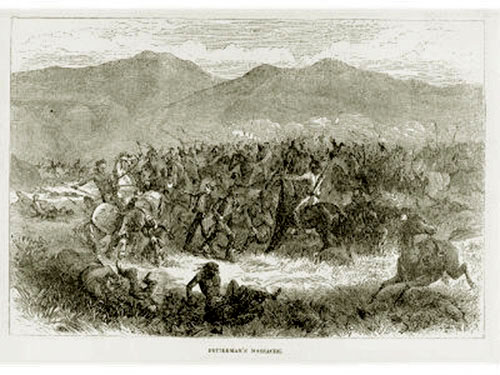
The battle at
Lodge Ridge Trail between Fetterman's troops and the Indians |
| Fetterman to a larger group of Indians. This group of Indians were
being lead by a young, intelligent warrior named Crazy Horse. The plan was
working. Fetterman was following the Indians. Crazy Horse and
his group were just hiding and waiting when they heard two canister shots
from the fort's howitzer. The shot had killed one of the warriors
from the decoy group. The Indians still on their horses kept running
and screaming, acting scared. Awkwardly as possible, Crazy Horse
called for a retreat, and kept running. The few mounted warriors
along with Crazy Horse stayed just out of shooting range. One at a
time a warrior would turn and act as if they were charging at the
soldiers, urging them on. Crazy Horse led his pursuers through the
hills, beyond the Big Piney, and onto the Lodge Ridge Trail. Along
the gullies, there were Indian scouts waiting for Fetterman. Crazy
Horse passed the Lodge Ridge Trail and toward the forks of Pano
Creek. And surprisingly, Crazy Horse let out a war cry.
Fetterman's troops were scattered everywhere. They tried to get back
together, tried to escape, and tried to form firing lines. Warriors
were coming from every which way and demolishing Fetterman's troops.
The Indians were coming at the soldiers with arrows and swinging clubs,
until Fetterman and his troops retreated to a knoll near the Bozeman
Trail. They were without horses, or any ammunition to protect
themselves with. This is where they took their last stand. All
of Fetterman's troops were killed, stripped of their weapons and clothing,
and scalped. This battle lasted only an hour and forty-five
minutes. This massacre forced the army to step back and look at how
much control they actually had. Several wars against Red Cloud,
later on, caused the government to notice they really needed to work
something out, because Red Cloud would not give them any mercy. |
|
| The Fetterman Massacre was only the
beginning of the wars Red Cloud fought against the army. If the white
men would have excepted the peace Red Cloud and his people gave at the
beginning, they wouldn't have had to go through this torture and
humiliation. As the trail became useless, the government
decided to temporarily retreat from the forts. There was a railroad being
constructed South of the trail. Finally, in 1868, the government
gave in to Red Cloud. Red Cloud asked that the forts be
deserted. Later in the summer, Fort Reno, Fort Kearney, and Fort
Smith were deserted. Then, Red Cloud rode through Fort Kearney and
scorched the despised emblem of white men's ownership of the
land. In November, Red Cloud traveled to Fort Laramie to sign a
peace treaty. Red Cloud was the only chief to win
"freedom" from the government. Red Cloud was talking to a
traveler once after his great victory against Fetterman. The traveler
was amazed that the government had given in. Red Cloud replied,
"I have more soldiers than the Great Father, and he cannot take my
lands against my will." |
|
| Red Cloud didn't fight in the Battle
of Little Bighorn or at Little Rosebud, but one of his sons fought in
each. He was more like an instructor. One fall morning, in
1876, some United States troops lead by Colonel McKenzie trapped Red
Cloud. He was sent to the Pine Ridge agency. In 1880, Red Cloud
appealed Professor Marsh of Yale for fraud. The professor was
conducting an expedition on the Bad Lands. The case was said to be
"worthy of official investigation." In 1890-1891, when the
"Ghost Dance craze" was going on. Red Cloud was accused of
collusion with the hostiles, however, he wasn't meeting them openly and
there was nothing that could be proved against him. |
|
|
His Good-Bye |
This is Red Cloud's good-bye to his
people:
"I shall soon lie down to rise no more
while my spirit is with my body the smoke of my breath shall be toward
the Sun for he knows all things and know that I am still true to him.
'My sun is set. My day is done.
Darkness is stealing over me. Before I lie down to rise no more,
I will speak to my people.'
'Hear me, my friends, for it is not the time
to tell you a lie. The Great Spirit made us the Indians, and
gave us buffalo, the antelope, and the deer for food and
clothing. We moved our hunting grounds from the Minnesota to the
Platte and from Mississippi to the Great Mountains. No one put
bounds on us. We were free as the winds, and like the eagle,
heard no man's command.'
'I was born a Lakota and shall die a
Lakota. Before the white man came to our country, the Lakotas
were a free people... As a child I was taught the Taku Wakan
(Supernatural Powers) were powerful and could do strange things... They
taught me that I could gain favor by being kind to my people and
brave before my enemies; by fighting for my people and their hunting
grounds... Taku Shanshan is familiar with my spirit and when I die I
will go with him... shadows are long and dark before me.' "
|
|
| Red Cloud led his people
to victory in the Fetterman Massacre. Their victory led to the
deserting of all the forts along the Bozeman Trail. Red Cloud
succeeded in keeping the land of his people under their control.
Without Red Cloud, his people might have all been harassed and raided and
the ones that survived would have gotten taken to a reservation and
wouldn't have had even close to as good as a life as what they did have
with Red Cloud. Red Cloud meant very much to his people. He
was one of their most important leaders. |
|
|
Stacie Cook
8th American History
Rossville Jr. High
Plains History Project
2004
|
Bibliography |






